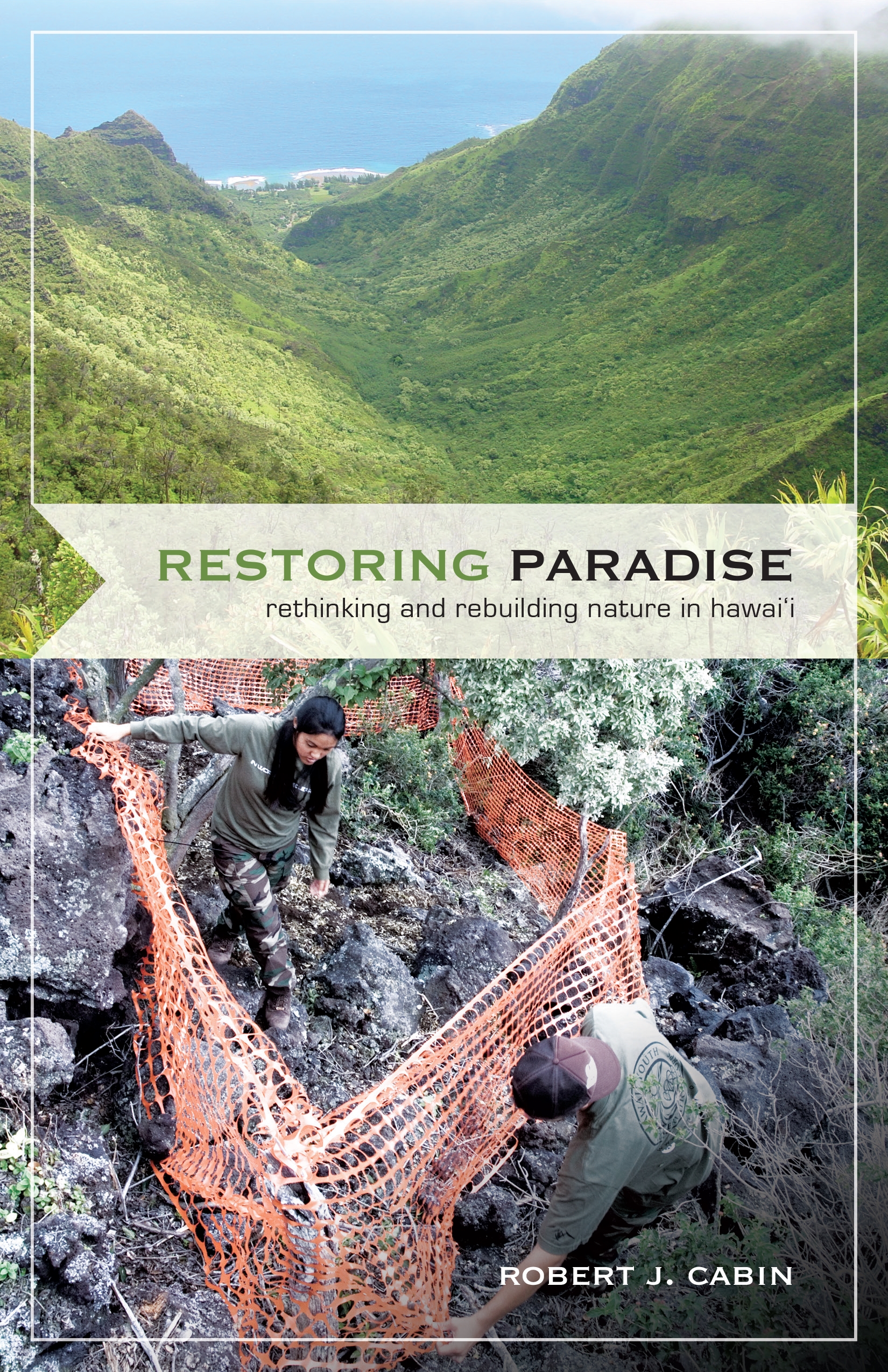Restoring Paradise: Rethinking and Rebuilding Nature in Hawaii
- About the Book
-
Three quarters of the U.S.’s bird and plant extinctions have occurred in Hawai‘i, and one third of the country’s threatened and endangered birds and plants reside within the state. Yet despite these alarming statistics, all is not lost: There are still 12,000 extant species unique to the archipelago and new species are discovered every year. In Restoring Paradise: Rethinking and Rebuilding Nature in Hawai‘i, Robert Cabin shows why current attempts to preserve Hawai‘i’s native fauna and flora require embracing the emerging paradigm of ecological restoration—the science and art of assisting the recovery of degraded species and ecosystems and creating more meaningful and sustainable relationships between people and nature.
Cabin’s extensive experience as a research ecologist and applied practitioner enables him to provide a rare, behind-the-scenes look at successful and inspiring restoration programs. In Part 1 he recounts Hakalau Forest National Wildlife Refuge’s efforts to restore thousands of acres of degraded pasture on the island of Hawai‘i back to the native rain forests that once dominated the area and sheltered native birds now on the brink of extinction. Along the way, he presents an overview of Hawaiian natural and cultural history, biogeography, and evolutionary biology. Following chapters look at restoration work underway by the U.S. Park Service to reestablish native species within the vast Hawai‘i Volcanoes National Park; by a charismatic scientist and dedicated volunteers to restore the native forests of Auwahi on the southern slopes of Haleakalā; and by the Limahuli branch of Kauai’s National Tropical Botanical Garden to revive a thousand-year-old taro plantation. To investigate the compelling and often conflicting philosophies and strategies of those involved in restoration, Cabin opens Part 3 with interview excerpts from a cross-section of Hawai‘i’s environmental community. He concludes with a provocative and insightful discussion of the contentious, evolving relationship between humans and nature and the power and limitations of science within and beyond Hawai‘i.
- About the Author(s)
-
Robert J. Cabin, Author
Robert J. Cabin is associate professor of ecology and environmental science at Brevard College. Before returning to academia, he worked as a restoration ecologist in Hawai‘i for the U.S. Forest Service and the National Tropical Botanical Garden.
- Reviews and Endorsements
-
- With the publication of Robert Cabin’s book we now have an opportunity to better understand some of the most vexing issues confronting conservationists, with the assurance of a balanced presentation free from the off-putting rhetoric that seems to accompany most conversations on these topics. I enthusiastically recommend this book to academics, community activists and all those interested in the future of nature.
—Biological Conservation - [Cabin] details the effort to mitigate the destruction wrought by invasive species and to restore natural habits for threatened native species. Even though such a task is daunting, Cabin's tone is hopeful and inspiring, showcasing real and heartening examples of success. . . . The book as a whole is a dynamic exploration of conservation efforts in native habitats.
—Publishers Weekly - Bob Cabin has that rare gift of a scientist who writes like a novelist. The tale he tells is not so much about science as it is about courageous people—many of them dedicated volunteers—who are responding in very personal ways to environmental crises. These are people who are restoring impaired Hawaiian ecosystems in a heroic effort to recover Nature. Cabin, who has logged many hours as a restoration practitioner himself, explains that we can’t always return Hawai‘i’s fabled ecosystems back to the way they were in the past. Instead, he recovers as much as possible of the remaining native biodiversity and gives Nature the opportunity to reinvent itself in a contemporary expression. The story Cabin tells is one of fulfillment as Hawaiians engage directly in natural processes as if they were part of their own evolving ecosystems—and indeed they are.
—Andre Clewell, Restoration Ecologist and President Emeritus, Society for Ecological Restoration - Robert Cabin’s book achieves a bold description and critique of efforts over the past four decades toward conservation/restoration of what’s left of native biological diversity in the Hawaiian Islands. He does a good job of articulating why this enterprise is a noble one but not so easy. Focusing on major and still evolving relative ‘success stories,’ Cabin’s narrative is lively while sometimes sharply critical of conservation science’s worthy efforts.
—Lloyd Loope, Research Biologist and Program Leader (retired), Haleakala Field Station, Maui
- With the publication of Robert Cabin’s book we now have an opportunity to better understand some of the most vexing issues confronting conservationists, with the assurance of a balanced presentation free from the off-putting rhetoric that seems to accompany most conversations on these topics. I enthusiastically recommend this book to academics, community activists and all those interested in the future of nature.
- Supporting Resources
-










